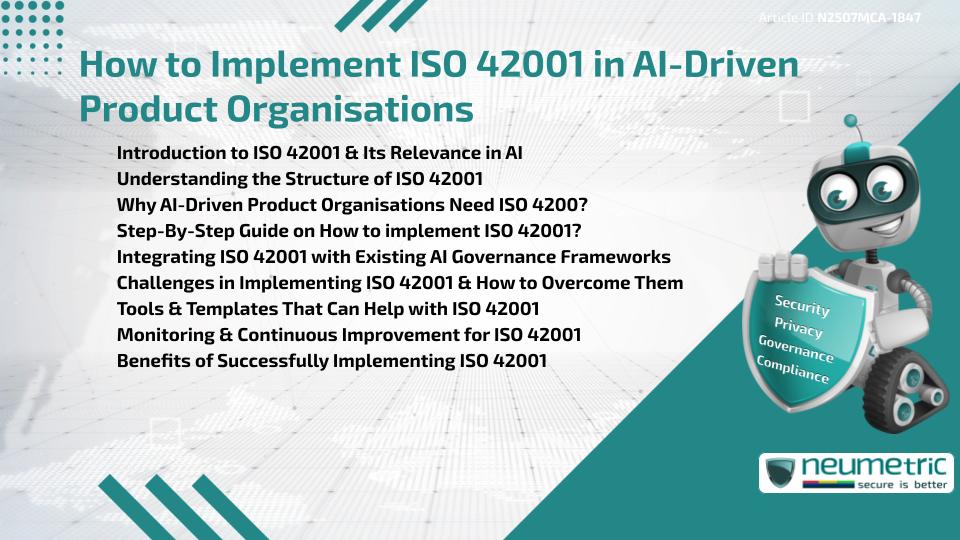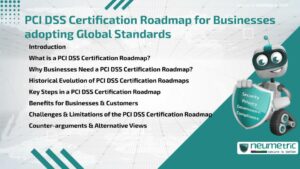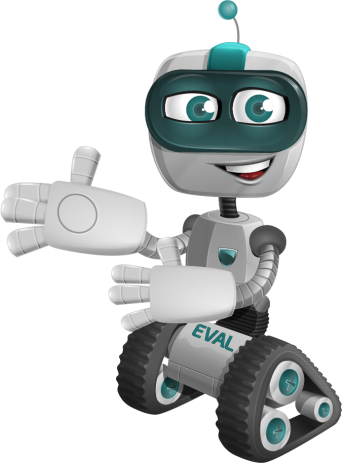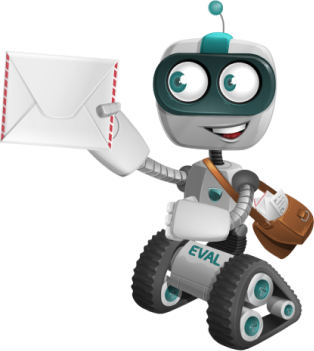Table of Contents
ToggleIntroduction to ISO 42001 & Its Relevance in AI
ISO 42001 is the first international Standard focused specifically on managing Artificial Intelligence [AI] systems responsibly. It provides a structured approach to establishing, implementing, maintaining & improving an AI Management System [AIMS]. For AI-driven product organisations, this Standard is critical because it helps balance innovation with ethical oversight & Risk Management.
With increasing global scrutiny around algorithmic bias, data misuse & transparency in automated systems, ISO 42001 offers a Framework to ensure accountability & alignment with organisational & societal values.
Understanding the Structure of ISO 42001
ISO 42001 follows the high-level structure similar to other ISO management systems, such as ISO 27001 & ISO 9001. This makes it easier for organisations already certified under those standards to align & integrate their efforts.
Key components include:
- Context of the organisation: Defining internal & external factors affecting AI Operations.
- Leadership: Ensuring top-level commitment & Governance.
- Planning: Identifying Risks & opportunities unique to AI Systems.
- Support: Allocating resources, training & awareness.
- Operation: Managing AI lifecycle, from design to decommissioning.
- Performance evaluation: Monitoring, measuring & auditing.
- Improvement: Taking Corrective Actions & continuous refinement.
Why AI-Driven Product Organisations Need ISO 4200?
Organisations building AI-driven products often operate in complex environments with shifting legal & ethical boundaries. Adopting ISO 42001:
- Builds trust with customers & regulators
- Reduces Risk of harm from AI decisions
- Improves internal consistency & accountability
- Prepares the organisation for upcoming AI Regulations
Moreover, it strengthens product quality & reinforces responsible innovation practices.
Step-By-Step Guide on How to implement ISO 42001?
The implementation process involves several structured phases. Here’s How to implement ISO 42001? in an AI-focused organisation:
1. Assess Organisational Readiness
Start by evaluating the maturity of your current AI Systems & Governance. Identify gaps in Risk Management, data handling, fairness & explainability. This baseline helps in planning realistic implementation goals.
2. Define Scope & Objectives
Determine which products, teams or geographies the AIMS will apply to. Be specific about what is included. This prevents overextension & ensures measurable success.
3. Secure Executive Support
Leadership must not only endorse but also participate in the process. They are key to aligning ISO 42001 goals with business strategy & resource allocation.
4. Establish a Cross-Functional AIMS Team
Form a team that includes product managers, data scientists, legal advisors & IT professionals. Each member plays a role in mapping Risks & controls across the AI lifecycle.
5. Develop Policies & Procedures
Document ethical AI principles, bias mitigation strategies, model validation methods & data Governance rules. Make sure these are aligned with ISO 42001 requirements.
6. Conduct Risk Assessments
Risk is central to ISO 42001. Conduct formal assessments to identify where AI Systems might cause harm, act unfairly or malfunction. Prioritise mitigation efforts.
7. Train Employees
Ensure that Employees involved in AI Development & oversight are trained on ISO 42001 Policies & understand their responsibilities. Awareness is critical for Compliance.
8. Implement Controls & Monitoring
Deploy controls such as model explainability checks, dataset audits & Feedback Loops. Build monitoring mechanisms to continuously evaluate system performance.
9. Perform Internal Audit
Review your AIMS implementation through internal audits. Address any nonconformities & make improvements.
10. Apply for Certification
Choose an accredited certification body to conduct the Audit. If successful, you will receive ISO 42001 Certification.
Each of these steps is essential to fully answer the question: How to implement ISO 42001?
Integrating ISO 42001 with Existing AI Governance Frameworks
Many organisations already follow internal AI Governance models or principles from bodies such as the OECD or NIST. ISO 42001 does not aim to replace these but to complement them.
Organisations should map their existing controls to ISO 42001 clauses. This ensures alignment while minimising duplication of effort.
Challenges in Implementing ISO 42001 & How to Overcome Them
Lack of Expertise
AI ethics & ISO standards require different skill sets. Bridging this gap may require hiring external consultants or training internal teams.
Dynamic AI Models
Many AI Models evolve post-deployment. ISO 42001 addresses this by requiring monitoring & version control, but it can still be resource-intensive.
Data Governance Complexities
AI depends on vast datasets, often from diverse sources. Ensuring legal & ethical Compliance across the data pipeline is not trivial.
To overcome these, adopt modular Policies, use automated Compliance tools & prioritise high-Risk use cases first.
Tools & Templates That Can Help with ISO 42001
A range of non-commercial resources are available to simplify implementation:
- ISO.org Overview of ISO 42001
- AI Risk Management Framework by NIST
- European Commission – AI Governance Policies
- UNESCO Recommendation on the Ethics of Artificial Intelligence
These tools provide templates for documentation, Risk registers & model Audit checklists.
Monitoring & Continuous Improvement for ISO 42001
ISO 42001 is not a one-time exercise. Once implemented, organisations must:
- Monitor key metrics such as bias rates & error margins
- Review controls after significant AI updates
- Conduct periodic Internal & External Audits
- Update documentation as AI use cases evolve
This ensures that the AIMS remains relevant & effective over time.
Benefits of Successfully Implementing ISO 42001
When asked How to implement ISO 42001? many overlook the post-certification benefits:
- Stronger Stakeholder confidence
- Competitive differentiation
- Better control over AI-related Risks
- Easier Compliance with international AI Regulations
- Alignment with responsible AI principles
Takeaways
- ISO 42001 brings structure & accountability to AI System management.
- Implementation involves policy development, cross-functional coordination & Risk Management.
- It complements existing frameworks like NIST & OECD.
- Tools & templates simplify documentation & auditing.
- Continuous Improvement is vital for long-term success.
FAQ
How to implement ISO 42001?
Begin with a readiness assessment, define your scope, develop AIMS Policies & engage a certification body to complete the Audit.
Is ISO 42001 mandatory for AI organisations?
No, it is not mandatory but highly recommended for building trust & preparing for future regulations.
Can ISO 42001 be integrated with ISO 27001?
Yes, both use a similar structure, making it easier to align controls & audits across security & AI Governance.
What teams should be involved in ISO 42001 implementation?
Include legal, data science, product, Compliance & IT teams to cover all stages of the AI lifecycle.
How long does it take to implement ISO 42001?
It depends on the organisation’s readiness, but typically ranges from three (3) to nine (9) months.
Do we need to train all Employees about ISO 42001?
Only those involved in the development, Governance & oversight of AI Systems require training aligned with ISO 42001.
What is the cost of implementing ISO 42001?
Costs vary based on size, scope & consultant involvement, but expect investment in training, documentation & Audit readiness.
Is there a Standard Audit checklist for ISO 42001?
Not yet, but many principles follow ISO’s general Audit approach. Tools from NIST & AlgorithmWatch can help bridge the gap.
Need help?
Neumetric provides organisations the necessary help to achieve their Cybersecurity, Compliance, Governance, Privacy, Certifications & Pentesting goals.
Organisations & Businesses, specifically those which provide SaaS & AI Solutions, usually need a Cybersecurity Partner for meeting & maintaining the ongoing Security & Privacy needs & requirements of their Clients & Customers.
SOC 2, ISO 27001, ISO 42001, NIST, HIPAA, HECVAT, EU GDPR are some of the Frameworks that are served by Fusion – a centralised, automated, AI-enabled SaaS Solution created & managed by Neumetric.
Reach out to us!





